Home office organization is all about creating a workspace that helps you focus and get things done. By setting up your environment thoughtfully, you can boost your productivity and make your work-from-home experience more enjoyable. Let’s take a look at some practical tips and tricks to get your home office in tip-top shape!
Utilizing Wall Space for Organization
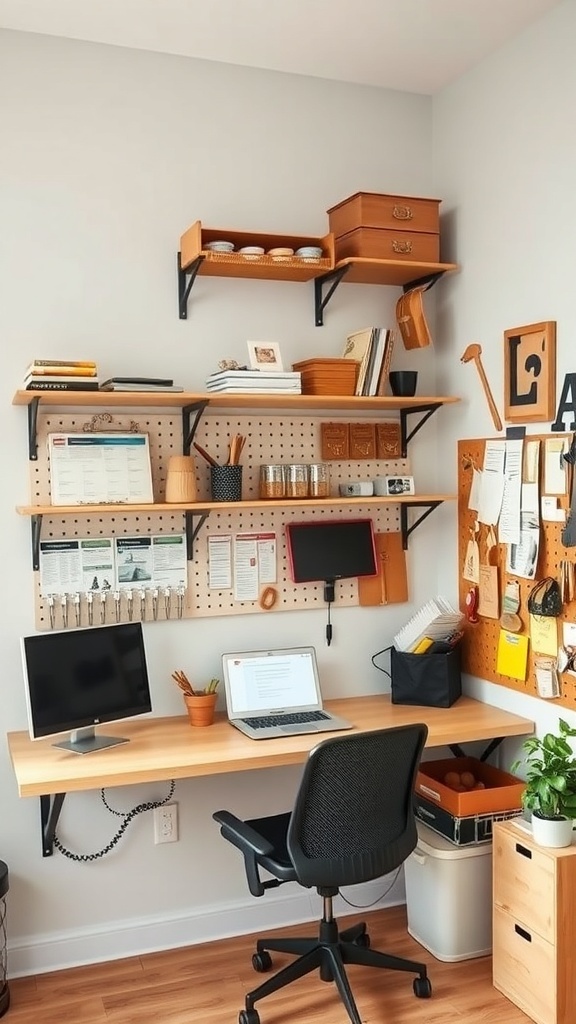
Maximizing wall space is a smart way to keep your home office tidy and functional. The image shows a well-organized workspace where every inch of the wall is put to good use. Shelves hold various items, making everything easily accessible.
The top shelf features decorative boxes and bowls, adding a touch of style while keeping supplies hidden. Below, a pegboard displays tools and notes, providing a practical solution for quick access. This setup encourages a clutter-free desk, allowing you to focus on your work.
Incorporating wall-mounted storage not only saves floor space but also creates a visually appealing environment. It’s all about finding the right balance between functionality and aesthetics. So, consider how you can transform your walls into an organizational asset!
Incorporating Technology Wisely
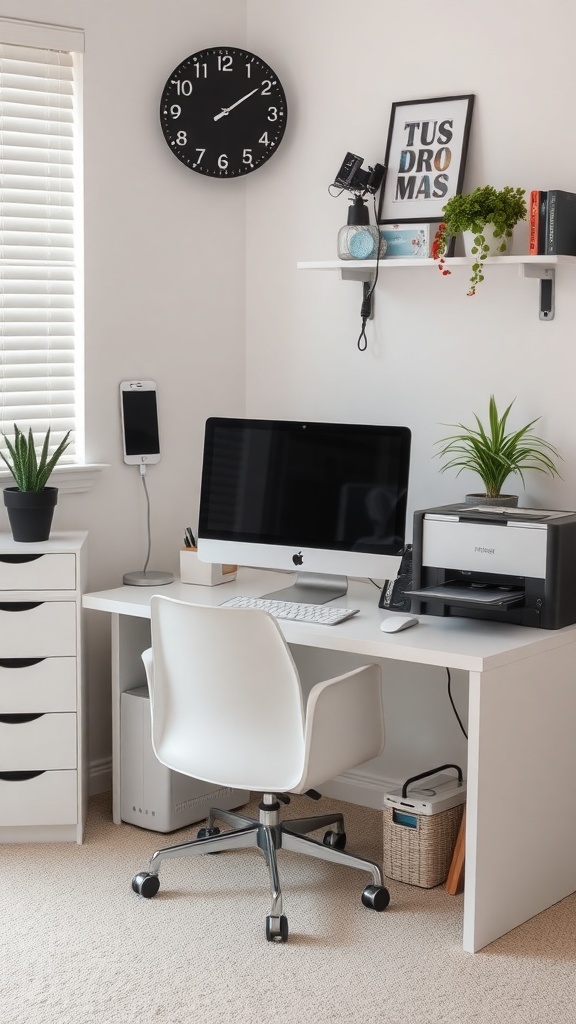
Creating a home office that feels right is all about balance. The image shows a clean, organized workspace that highlights the importance of technology in our daily tasks. A sleek computer sits on a tidy desk, making it easy to focus on work without distractions.
Notice the printer nearby. It’s a handy tool for those who need hard copies of documents. Keeping it close saves time and keeps everything within reach. The white color scheme adds a fresh touch, making the space feel open and inviting.
Plants add a nice touch of life to the office. They not only brighten the space but also improve air quality. A little greenery can boost your mood and productivity. The clock on the wall helps keep track of time, ensuring you stay on schedule.
Smartphone charging stations are essential in today’s tech-driven world. Having your phone charged and ready to go keeps you connected without cluttering your desk. Overall, this setup shows how to blend technology with organization for a functional and pleasant workspace.
Incorporating Personal Touches
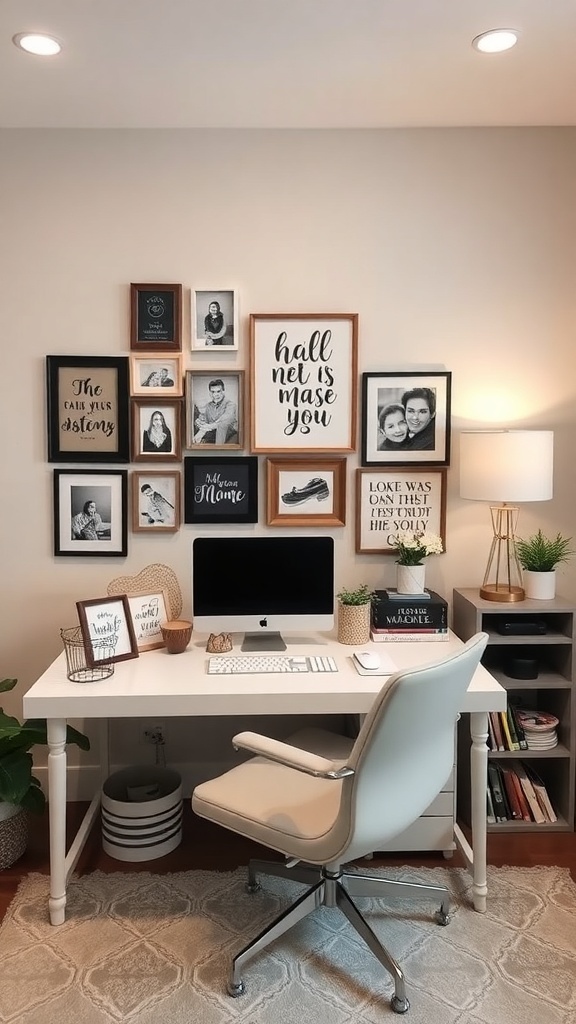
Your home office should feel like a space that reflects who you are. The image shows a beautifully organized desk with a personal touch. The wall behind the desk is adorned with framed photos and inspirational quotes. This setup creates a warm and inviting atmosphere, making it easier to focus on work.
The desk itself is simple yet stylish, with a clean design that keeps distractions at bay. A few plants add a splash of greenery, bringing life into the workspace. The combination of personal photos and motivational messages can inspire creativity and keep you grounded during busy workdays.
Consider adding your favorite items to your office. Whether it’s a cherished photo, a piece of art, or a fun desk accessory, these elements make the space uniquely yours. Personal touches can transform a standard office into a cozy nook where you enjoy spending time.
Effective Storage Solutions
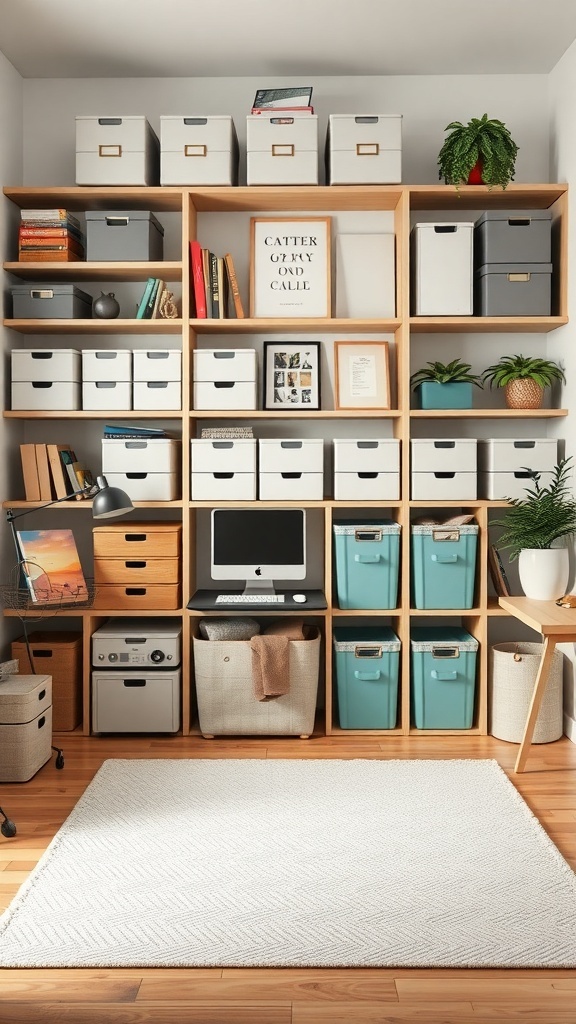
When it comes to organizing your home office, effective storage solutions can make a huge difference. The image shows a well-arranged shelving unit filled with various storage boxes and decorative items. This setup not only looks tidy but also maximizes space.
The shelves are a mix of open and closed storage. The closed boxes keep clutter hidden, while the open shelves display books and a few personal touches like plants and pictures. This balance is key to creating a functional workspace.
Using labeled boxes can help you quickly find what you need. The different colors of the boxes add a fun pop to the room while serving a practical purpose. Consider using similar storage solutions to keep your office organized and visually appealing.
Don’t forget about the desk area! A clean desk with minimal items can boost productivity. The image shows a sleek computer setup with just a few essentials, which is a great way to maintain focus.
Designing a Productive Atmosphere
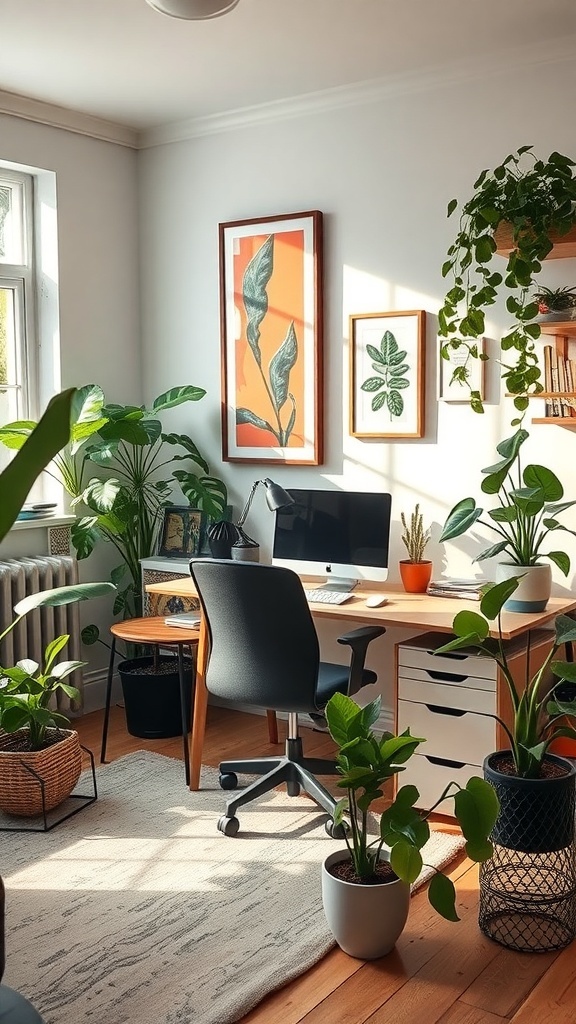
Creating a productive home office starts with the right design. The image shows a bright and inviting workspace filled with greenery. Plants not only add beauty but also improve air quality, making the space more refreshing.
The desk is organized and functional, featuring a computer and some personal touches like framed art. This setup encourages creativity and focus. Natural light pours in, enhancing mood and energy levels.
Choosing a comfortable chair is key for long hours of work. The black chair in the image looks both stylish and supportive. A cozy rug adds warmth and makes the space feel more inviting.
Overall, this home office design promotes productivity and well-being. It’s a reminder that a well-organized space can inspire great work.
Decluttering Your Desk
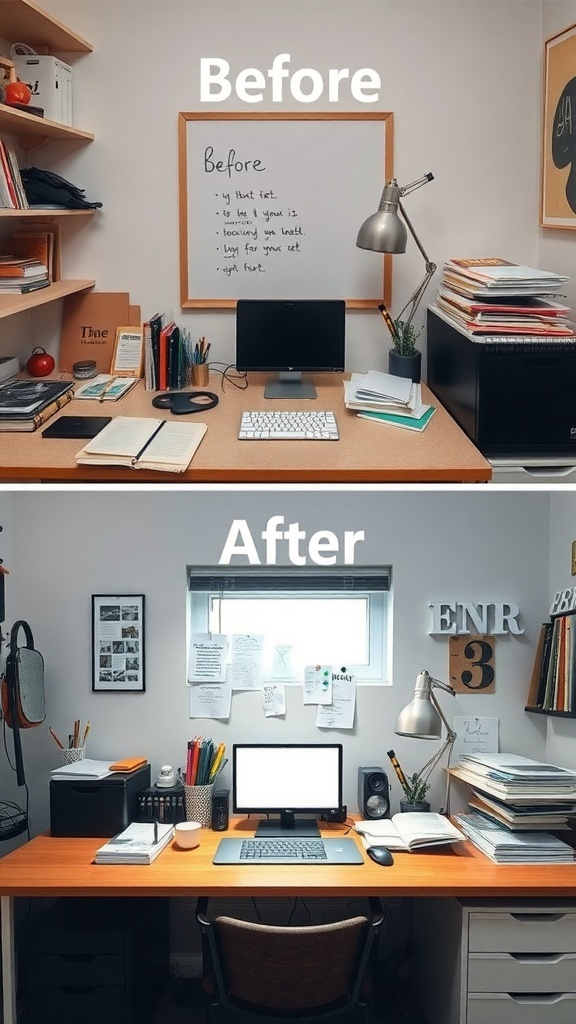
Decluttering your desk can make a big difference in how you feel while working. The image shows a clear transformation from a messy workspace to a tidy one. On the left, the desk is cluttered with books, papers, and various items that can distract you. On the right, everything is organized, creating a calm and inviting space.
Start by removing everything from your desk. This helps you see what you really need. Keep only the essentials, like your computer, a notepad, and a few pens. The rest can go into storage or be tossed out.
Next, think about how you use your space. Place items you need frequently within arm’s reach. Use organizers for papers and supplies to keep everything neat. The after image shows how effective this can be. A clean desk not only looks good but also boosts your productivity.
Finally, maintain your new setup. Take a few minutes at the end of each day to tidy up. This simple habit will keep your workspace clutter-free and ready for a fresh start each morning.
Creating a Paper Management System
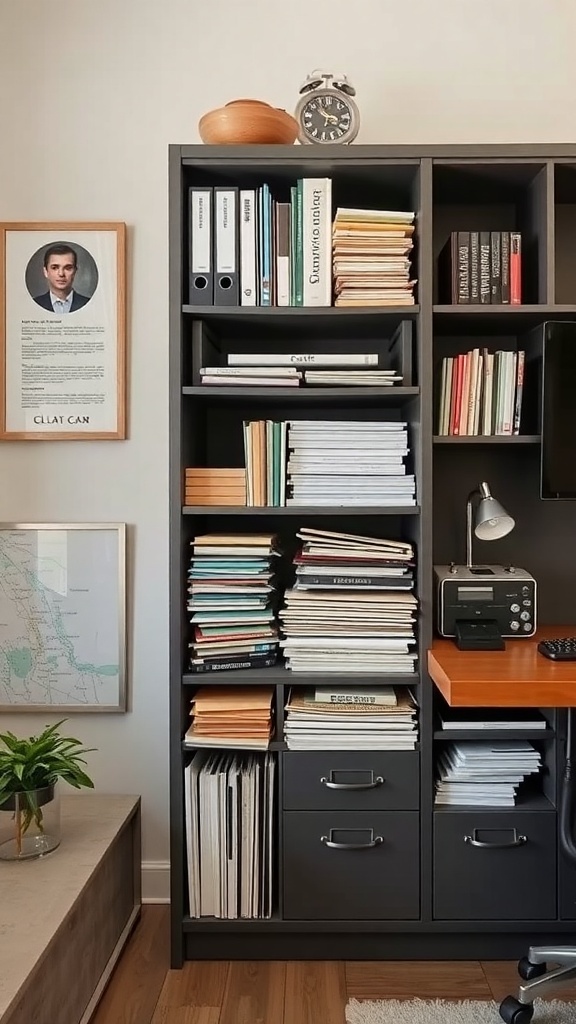
Managing paper in your home office can feel overwhelming. The image shows a well-organized bookshelf filled with neatly arranged files and documents. This setup is a great example of how to create a paper management system that works for you.
Start by sorting your papers into categories. You can use binders, folders, or even boxes to keep everything organized. Label each section clearly. This makes it easy to find what you need without digging through piles of paper.
In the image, you can see different colors of folders. Using color coding can help you quickly identify categories. For instance, use blue for financial documents and green for project files. This simple trick can save you time and reduce stress.
Don’t forget to set aside a space for incoming papers. A small tray or box can help you manage new documents as they come in. Make it a habit to sort through this space regularly. This keeps your workspace tidy and prevents clutter from building up.
Finally, consider going digital when possible. Scanning important documents can help reduce paper clutter. You can store them on your computer or in the cloud for easy access. This way, you keep your home office organized and efficient.
Creating a Functional Workspace
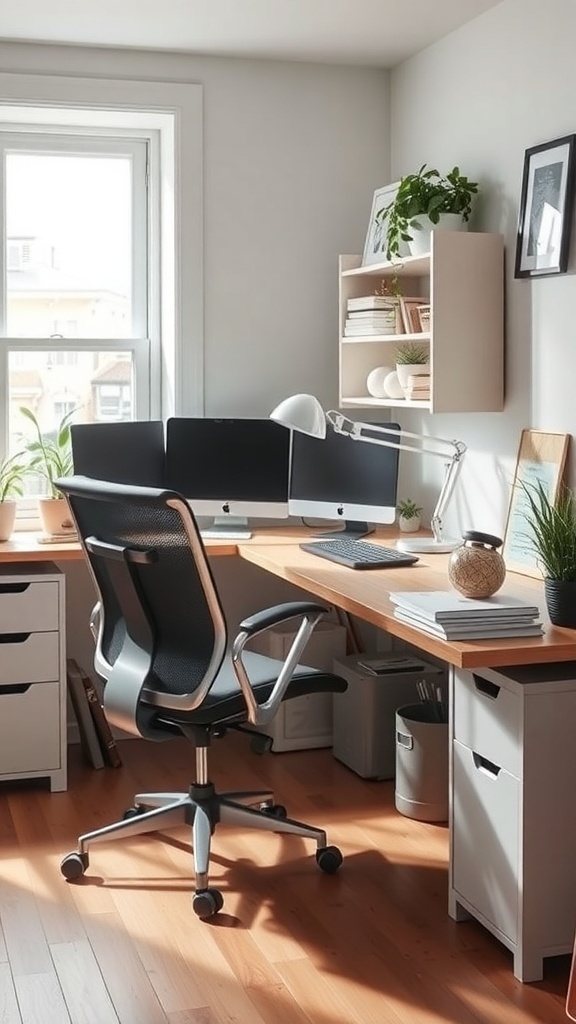
Setting up a home office can be a fun project. The right layout and organization can make a big difference in how you feel while working. In the image, we see a bright and inviting workspace that encourages productivity.
The desk is spacious, allowing for two monitors, which is great for multitasking. Having multiple screens can help you manage tasks more efficiently. The ergonomic chair is another key element, providing comfort during long hours of work.
Natural light streams in through the window, creating a warm atmosphere. Plants on the desk and shelves add a touch of life, making the space feel more welcoming. They can also improve air quality, which is a nice bonus.
Storage solutions are visible, with drawers and shelves keeping everything organized. This helps reduce clutter and keeps your mind clear. A tidy workspace can lead to better focus and creativity.
Overall, this setup shows how thoughtful design can create a functional workspace. It’s a reminder that a well-organized home office can enhance your work experience.
Implementing Time Management Tools
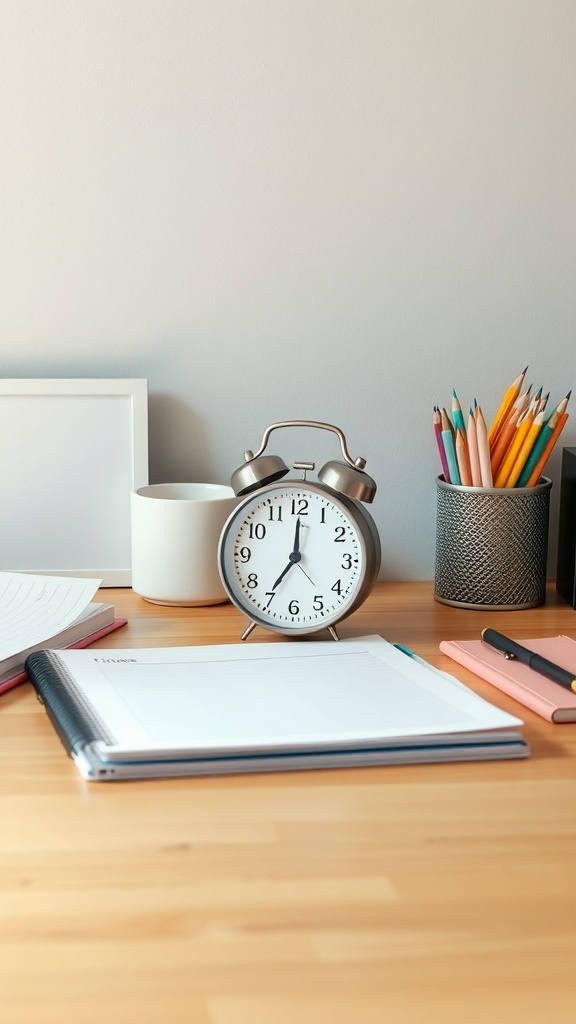
Time management tools are essential for keeping your home office organized. The image shows a tidy desk with a classic alarm clock, colorful pencils, and a few notebooks. This setup promotes a focused work environment.
The alarm clock serves as a reminder to stay on schedule. Setting specific times for tasks can help you manage your day better. Use it to break your work into manageable chunks, allowing for breaks in between.
Having a clean workspace, as shown in the image, is also key. A clear desk reduces distractions and helps you concentrate. Keep only the essentials on your desk, like your notebooks and pens, to maintain a clutter-free area.
Consider using planners or digital tools to track your tasks. This way, you can visualize what needs to be done and prioritize effectively. The notebooks in the image suggest jotting down ideas and plans, making it easier to stay organized.
Creating a Distraction-Free Zone
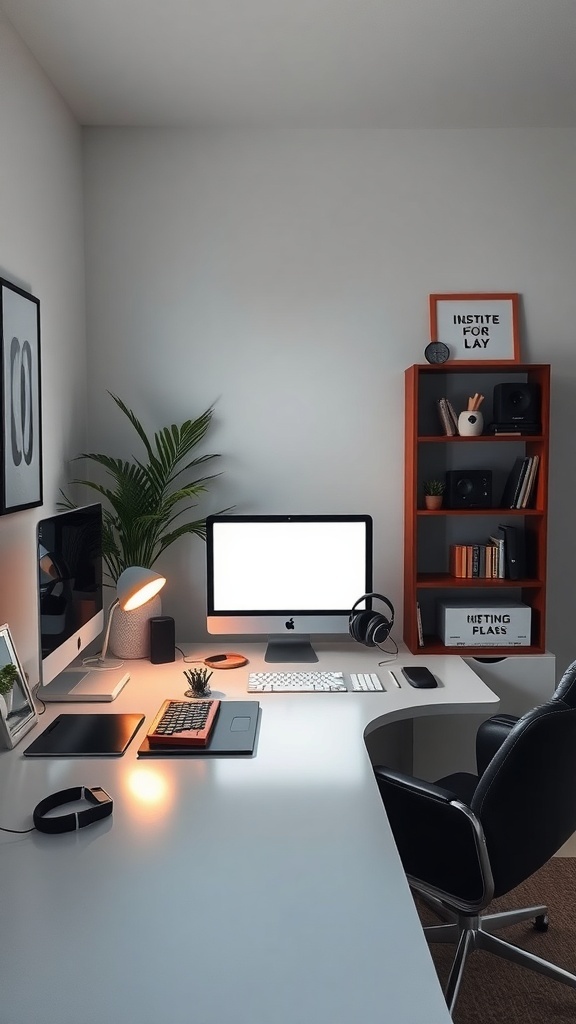
Setting up a home office can be a fun project, especially when you focus on creating a distraction-free zone. The image shows a sleek, organized workspace that promotes productivity. The clean lines and minimal clutter make it easy to concentrate on tasks.
The desk features a modern computer, a tablet, and a stylish keyboard. This setup is not only functional but also visually appealing. A small plant adds a touch of nature, which can help reduce stress and improve focus.
Lighting plays a key role in maintaining a distraction-free environment. The lamp on the desk provides soft illumination, making it easier to work without straining your eyes. The headphones nearby suggest a way to block out noise, allowing you to dive deep into your work.
On the wall, there are organized shelves with books and decorative items. This keeps everything within reach while avoiding visual clutter. A clear space helps your mind stay clear too. Consider adding personal touches that inspire you, but keep them minimal to avoid distractions.
Overall, this workspace is a great example of how to create a distraction-free zone. By keeping things tidy and intentional, you can make your home office a place where you can truly focus and get things done.
Setting Up a Comfortable Chair
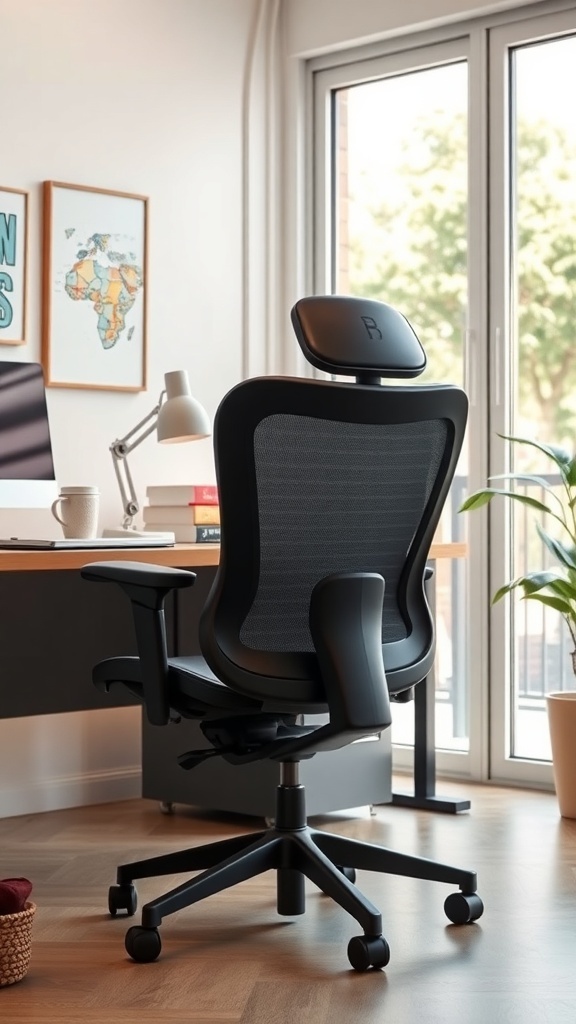
Choosing the right chair for your home office is key to staying comfortable during long work hours. The image shows a sleek, ergonomic chair that supports your back and promotes good posture. This is important for maintaining focus and productivity.
The chair’s design features a mesh back, which allows for airflow, keeping you cool while you work. The adjustable height and armrests make it easy to find your perfect fit. This ensures that your body is well-supported, reducing strain on your neck and shoulders.
Positioning your chair correctly is just as vital. Make sure your feet rest flat on the floor, and your knees are at a right angle. This setup helps you stay comfortable and focused on your tasks. A good chair can make a big difference in your work experience.
Organizing Cables and Wires
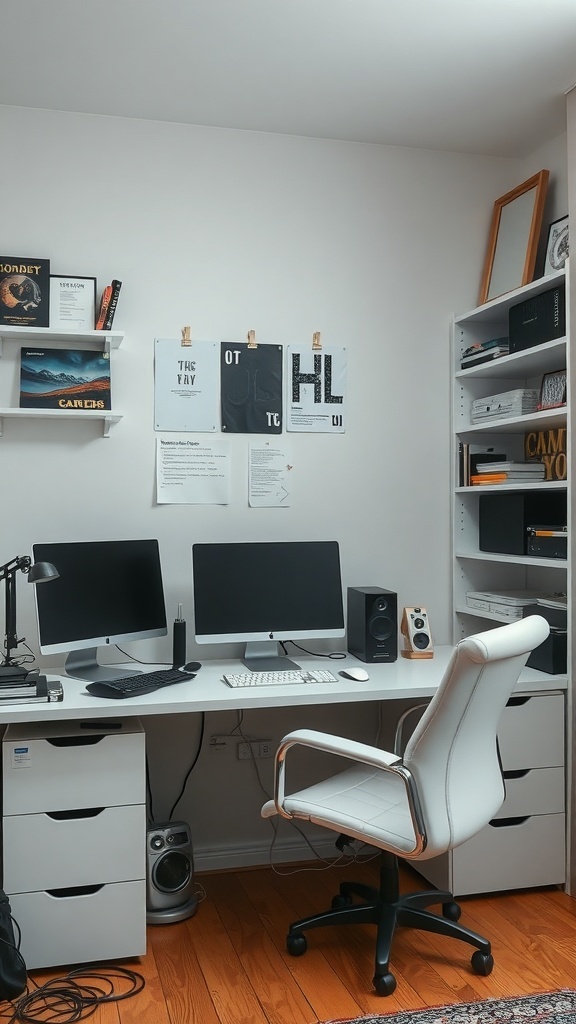
Keeping your home office tidy is key to staying productive. One of the biggest challenges is managing cables and wires. In the image, you can see a clean workspace with minimal visible cables, which creates a more inviting atmosphere.
Using cable organizers is a great way to keep everything in check. You can find clips, sleeves, or even boxes designed to hide those pesky wires. Notice how the desk in the photo has a few cables neatly tucked away, making it look professional and organized.
Labeling your cables can also save you time and frustration. When you know which cable goes where, you can easily unplug or switch devices without a hassle. This simple step can make a big difference in your daily routine.
Lastly, consider using wireless devices when possible. Wireless keyboards and mice can reduce the number of cables on your desk. The clean look of the workspace in the image shows how effective this can be.
Establishing a Daily Routine
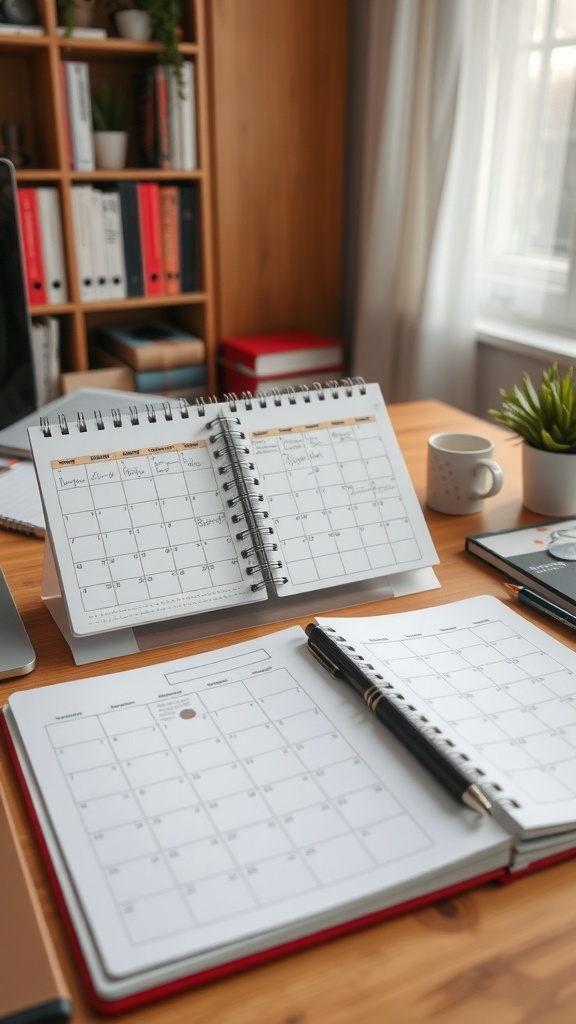
Creating a daily routine is key to staying organized in your home office. The image shows a well-arranged workspace with planners and calendars, which are essential tools for planning your day. Having a clear view of your tasks helps you focus and manage your time effectively.
Start by setting specific times for your work hours. This creates a boundary between work and personal time. Use the planners in the image to jot down your daily goals and appointments. This way, you can keep track of what needs to be done and when.
Incorporate breaks into your routine. Short breaks can refresh your mind and boost productivity. The coffee cup in the image suggests a perfect moment to step away and recharge. Remember, a balanced routine is not just about work; it’s also about taking care of yourself.
Finally, review your routine weekly. Adjust it as needed to find what works best for you. A flexible approach allows you to adapt to changes while keeping your workspace organized and efficient.